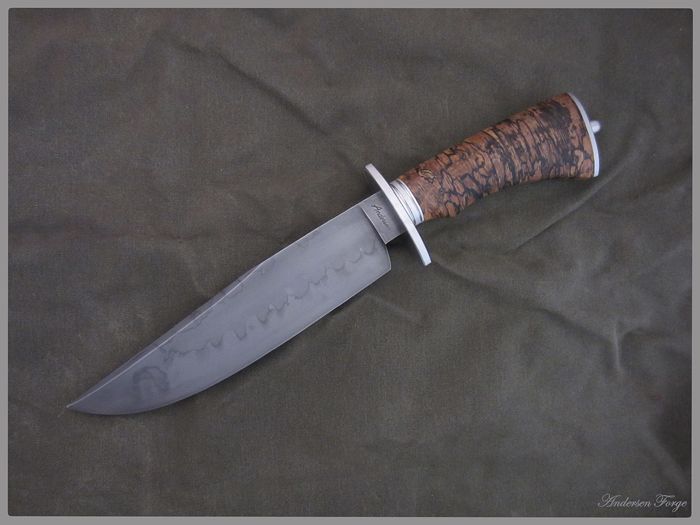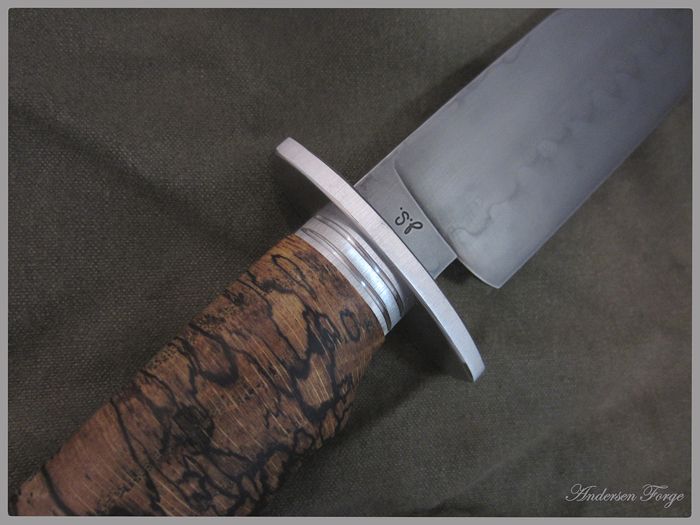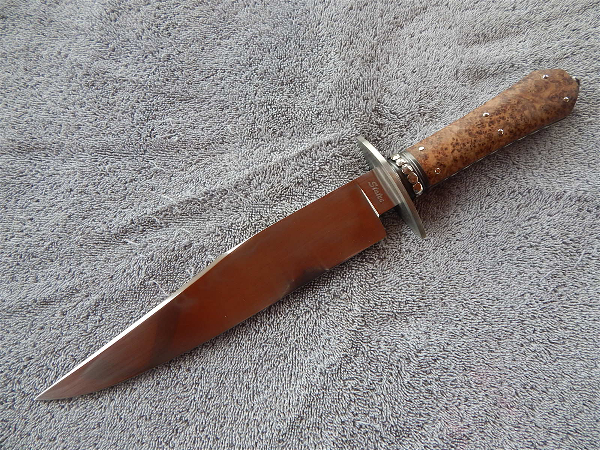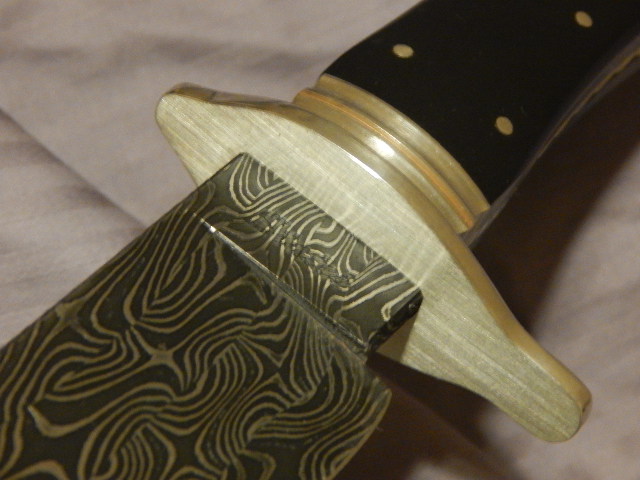I'm just getting started making Bowies and need some advise on how wide/long to make the oval guard.
Joey,
What you ask has no definite rule but is often subjective. As a general rule an oval guard should extend slightly farther down than up and should be no wider than 1" and usually less.
Usually the handle width will correspond with the width of the ricasso meaning that the guard must extend farther down on the blade than up to balance any recess in the choil. I would suggest making one that is over-sized and sliding it in place over the tang. If you have the handle completed then slide it in place as well. It will then be easy to see where you will need to remove material in order to get a balanced look & feel.
Here's an example of an oval guard to give you an idea:

|quoted:
Joey,
What you ask has no definite rule but is often subjective. As a general rule an oval guard should extend slightly farther down than up and should be no wider than 1" and usually less.
Usually the handle width will correspond with the width of the ricasso meaning that the guard must extend farther down on the blade than up to balance any recess in the choil. I would suggest making one that is over-sized and sliding it in place over the tang. If you have the handle completed then slide it in place as well. It will then be easy to see where you will need to remove material in order to get a balanced look & feel.
Here's an example of an oval guard to give you an idea:

Thanks,Gary! That helps!
I'm going to throw my two cents in for what it's worth. I won't speak to the size of the oval but I will say don't make it too thick. I have seen some that my eyes just stop at the big clunky looking oval guard that looks like it makes the knife heavy.
Joey, I apply this general rule that I was taught. 3/4" above the spine, 1" below the bottom of the ricasso. If your ricasso is in proper proportion to the blade, it should look nice. Width of the oval about 3/4-5/8" I like to have just a bit of the oval extended past the width of the spacer, which will be the sane width as the handle. I make most of my ovals from 1/8"-3/16" stock depending on whether I leave them rounded, filed or fluted on the edge. Trace the blade, and play with the dimensions of the guard, spacer and handle in the drawing. Go with what is pleasing to the eye.
Best,
Bob
I try to keep mine a maximum of .200"
1/4" is just too thick.
I begin by shaping the bottom of the guard so it extends below the CUTTING EDGE the same distance as the top extends ABOVE the spine. If it looks out of proportion, then I will reduce it.
When folks make the oval guard centered on the ricasso, they just look awkward to me.
Karl B. Andersen
Journeyman Smith
So much of this is personal taste and subjective, isn't it?
It seems to me that applying dimensional rules of fixed sizes (3/4" wide, 5/8" this side or that) fails to take into consideration the proportions when compared to the blade, handle, etc.
For me the size of the guard is a proportions question, rather than a set dimension range question.
The subjective aspect is exemplified by Karl: When folks make the oval guard centered on the ricasso, they just look awkward to me.
To me it's just the opposite. I see the guard in relation to the ricasso and the handle width. Different extensions one side or the other look unbalanced and awkward to me, on a symmetrical guard. So, I usually center my oval guards on the handle and ricasso.
An asymmetrical double branch guard is different for me. If the guard is not symmetrical top and bottom, I prefer the top extending less than the bottom. I always extend the lower branch below the cutting edge as Karl stated. Usually enough to accomodate full coverage of a grown-up's index finger!
Joshua States
www.dosgatosforge.com
https://www.youtube.com/channel/UCdJMFMqnbLYqv965xd64vYg
https://www.facebook.com/dos.gatos.71
Also on Instagram and Facebook as J.States Bladesmith
“So I'm lightin' out for the territory, ahead of the scared and the weak and the mean spirited, because Aunt Sally is fixin’ to adopt me and civilize me, and I can't stand it. I've been there before.â€
If I were to expand on this a bit, I would bring up the "form follows function" rule and how it applies to fittings and handle design as well as blade shape and dimensions. Here are my thoughts, discussion is welcome.
If the knife is a "Gentleman's Bowie" (less than 7" blade" it will be more slender and sleek. The guard should emulate that. The knife is intended for minimal use, and light duty at best. The guard will not extend far past the side outline of the spacers in order to be in proportion to the blade and right for the intended use. The lower and upper extensions should also be minimal, but provide enough coverage for the fingers.
If the knife is more of a general use, medium duty, knife (7" to 9" blade), this is something that would be used in a variety of conditions. Foul weather, rough work, etc. The user's hand requires a bit more protection from sliding past the guard onto the blade, so the guard will be larger and extend further from the profile edge of the spacers. Once again, the blade and guard dimensions are proportional and sized for function.
If the knife is a large one (9" or larger blade) it really is intended for hard work and most likely fighting/self-defense. This requires more hand protection for the user, so the guard should be larger. This knife could be buried up to the hilt in an opponent and you wouldn't want the guard getting inside the body cavity and getting caught, making removal difficult. The user could also use the knife to parry another knife or saber so the guard should provide enough coverage to protect the hand.
Joshua States
www.dosgatosforge.com
https://www.youtube.com/channel/UCdJMFMqnbLYqv965xd64vYg
https://www.facebook.com/dos.gatos.71
Also on Instagram and Facebook as J.States Bladesmith
“So I'm lightin' out for the territory, ahead of the scared and the weak and the mean spirited, because Aunt Sally is fixin’ to adopt me and civilize me, and I can't stand it. I've been there before.â€
|quoted:
Joey, I apply this general rule that I was taught. 3/4" above the spine, 1" below the bottom of the ricasso. If your ricasso is in proper proportion to the blade, it should look nice. Width of the oval about 3/4-5/8" I like to have just a bit of the oval extended past the width of the spacer, which will be the sane width as the handle. I make most of my ovals from 1/8"-3/16" stock depending on whether I leave them rounded, filed or fluted on the edge. Trace the blade, and play with the dimensions of the guard, spacer and handle in the drawing. Go with what is pleasing to the eye.
Best,
Bob
Great advice! Just looking for a starting point and you hit it on the nail (guard)! Thanks!
|quoted:
If I were to expand on this a bit, I would bring up the "form follows function" rule and how it applies to fittings and handle design as well as blade shape and dimensions. Here are my thoughts, discussion is welcome.
If the knife is a "Gentleman's Bowie" (less than 7" blade" it will be more slender and sleek. The guard should emulate that. The knife is intended for minimal use, and light duty at best. The guard will not extend far past the side outline of the spacers in order to be in proportion to the blade and right for the intended use. The lower and upper extensions should also be minimal, but provide enough coverage for the fingers.
If the knife is more of a general use, medium duty, knife (7" to 9" blade), this is something that would be used in a variety of conditions. Foul weather, rough work, etc. The user's hand requires a bit more protection from sliding past the guard onto the blade, so the guard will be larger and extend further from the profile edge of the spacers. Once again, the blade and guard dimensions are proportional and sized for function.
If the knife is a large one (9" or larger blade) it really is intended for hard work and most likely fighting/self-defense. This requires more hand protection for the user, so the guard should be larger. This knife could be buried up to the hilt in an opponent and you wouldn't want the guard getting inside the body cavity and getting caught, making removal difficult. The user could also use the knife to parry another knife or saber so the guard should provide enough coverage to protect the hand.
All good stuff! Thanks so much!
|quoted:
I try to keep mine a maximum of .200"
1/4" is just too thick.
I begin by shaping the bottom of the guard so it extends below the CUTTING EDGE the same distance as the top extends ABOVE the spine. If it looks out of proportion, then I will reduce it.
When folks make the oval guard centered on the ricasso, they just look awkward to me.
Thanks Karl! Great knife by the way!
|quoted:
So much of this is personal taste and subjective, isn't it?
It seems to me that applying dimensional rules of fixed sizes (3/4" wide, 5/8" this side or that) fails to take into consideration the proportions when compared to the blade, handle, etc.
For me the size of the guard is a proportions question, rather than a set dimension range question.
The subjective aspect is exemplified by Karl: When folks make the oval guard centered on the ricasso, they just look awkward to me.
To me it's just the opposite. I see the guard in relation to the ricasso and the handle width. Different extensions one side or the other look unbalanced and awkward to me, on a symmetrical guard. So, I usually center my oval guards on the handle and ricasso.
An asymmetrical double branch guard is different for me. If the guard is not symmetrical top and bottom, I prefer the top extending less than the bottom. I always extend the lower branch below the cutting edge as Karl stated. Usually enough to accomodate full coverage of a grown-up's index finger!
Another opinion. I'm starting to get a feel for what to look for in my design. I appreciate your point of view. Thanks so much!
FYI: Per the ABS JS judging guideline #10: Ovals should be symmetrical, and guards should be centered.
http://www.americanbladesmith.com/index.php?section=pages&id=172
Joshua States
www.dosgatosforge.com
https://www.youtube.com/channel/UCdJMFMqnbLYqv965xd64vYg
https://www.facebook.com/dos.gatos.71
Also on Instagram and Facebook as J.States Bladesmith
“So I'm lightin' out for the territory, ahead of the scared and the weak and the mean spirited, because Aunt Sally is fixin’ to adopt me and civilize me, and I can't stand it. I've been there before.â€
Joshua the guard centered refers to centered side to side not top to bottom. Can't have the guard being fatter on one side than the other. Personally I am with Karl, mine are slightly longer on the bottom. I just feel it looks better.
Brion
Brion Tomberlin
Anvil Top Custom Knives
ABS Mastersmith
Brion, I wasn't insinuating anything else. I just put it up as an FYI for Joey.
Joshua States
www.dosgatosforge.com
https://www.youtube.com/channel/UCdJMFMqnbLYqv965xd64vYg
https://www.facebook.com/dos.gatos.71
Also on Instagram and Facebook as J.States Bladesmith
“So I'm lightin' out for the territory, ahead of the scared and the weak and the mean spirited, because Aunt Sally is fixin’ to adopt me and civilize me, and I can't stand it. I've been there before.â€






